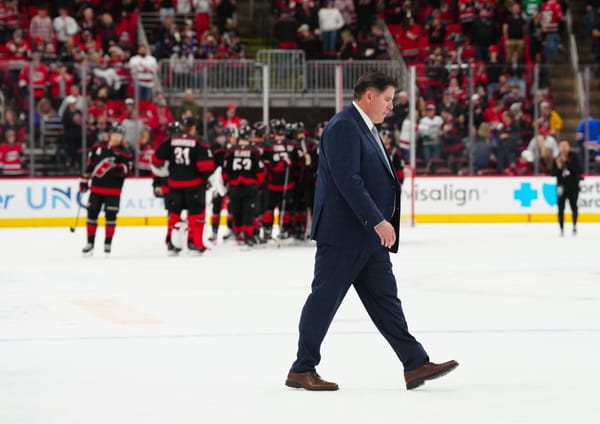Neal Pionk Can Not Outscore His Deficiencies
Arguments made from those skeptical of the value of particular offensive defensemen usually follow the same script. Criticisms are made regarding the risks and costly turnovers the player might make. The player’s defensive ability is heavily scrutinized. The judgment is laid down; the player is “one-dimensional” and therefore limited, if not altogether a liability to his team when he’s on the ice.
The narrative is often false. It was (and still is) false regarding Erik Karlsson, whose defensive game is actually quite strong, no matter what many Norris voters might say. It was also false when even judging the likes of Keith Yandle and Mike Green, whose positive contributions far outweighed any problems they created.
Is is a bit ironic, then, that Neal Pionk has largely flown under the radar this season. Because for all the times that such a false narrative was poorly applied, Pionk is one player for whom it actually holds up.
Let’s first cut to the chase here. Neal Pionk has 20 points in 42 games this season and 34 points through 70 career games. Yet despite this, Pionk ranks poorly by virtually every encompassing statistic available publicly.
Let’s first cover all bases here; Wins Above Replacement (WAR) and similar statistics are hardly perfect. There are blind spots to certain parts of the game such as the influence of teammates and tactics. Hockey is complicated and hard to predict and so perfectly encapsulating a player’s entire worth into one number is impossible. These numbers are estimates.
In any case, the numbers are still striking and line up with what this writer, at least, has seen on the ice. He has been below replacement value and thus, at least statistically, has not played up to the standard of even a depth NHL defenseman.
Here is a telling breakdown of Pionk’s Goals Above Replacement (GAR) from Evolving Hockey.
There’s a lot to take in here, but the primary sticking point is that Pionk’s even strength performance is a poison pill that can’t be salvaged by the rest of his game. At least, that’s been the so far this season. That can be explained in a few ways.
First, though he has helped put the puck in the net this season, the majority of his production has come on the power play (more on that later). Just seven of his 20 points have been registered five-on-five, which is not great for an offensive defenseman. Though Pionk ranks 39th overall among defensemen in points-per-60 minutes (minimum 500 minutes), he falls all the way to 114th (among 157 defensemen) when isolating for five-on-five.
But that’s really small potatoes compared to the bigger problem, which is this; the Rangers get absolutely piled on when Neal Pionk is on the ice. After adjusting for score, the Rangers have given up roughly 170 more shots with Pionk on the ice at five-on-five than they’ve taken themselves (via Corsica Hockey.) That gives him the fourth-worst Corsi For Percentage of 157 defensemen who have played at least 500 minutes this season. In terms of expected goals, they’re roughly 29 against versus just 23 in his favor. To be fair, this is somewhat a product of the team. The Rangers are not a good team, and that drags everyone down. Nonetheless, Pionk performs very poorly even relative to the rest of the team.
The biggest problem with Pionk’s game is clearly on the defensive side. He simply is not a good defender in his own zone. He is constantly late to his net-front assignments and also outmuscled in battles for positioning.
This would also explain his horrific penalty killing numbers. It’s a big issue in his game, and he needs to improve here to have a legitimate NHL career. Still, he’s not the first offensive defenseman to struggle at defending in his own end. The bigger issue for Pionk is through the neutral zone. To be frank, he might as well not even defend the rush. In the 10 games tracked Corey Snajzder, Pionk broke up just one of 78 zone entry attempts against him. What’s more, teams rarely have to dump the puck against Pionk, carrying the puck cleanly into the offensive zone three out of every four attempts. Roughly 90% of NHL defensemen out-perform him, according to Snajzder’s tracking. Overall, Pionk ranks among the absolute worst in the NHL in terms of defending the blue line.
Here is the more stunning finding, though: Pionk struggles at advancing the puck. Per Snajzder’s tracking, Pionk ranks below average in terms of creating zone exits as well as zone entries.
(Chart via CJ Turturo)
It’s hard to imagine because Pionk is so proficient at dishing the puck within the offensive zone, but for whatever reasons he struggles at advancing the puck up the ice. His zone exit success rate mirrors that of the typical shot-blocking defenseman who can only dump the puck off the glass. His zone entries are better, but still well below the threshold of a thriving offensive defenseman.
Offensive defensemen like Matt Dumba and Justin Faulk, who struggle in their defensive zone coverages, are still overwhelmingly positive contributors thanks to respectable gap control and reads to protect the blue line and through elite puck moving ability. Pionk, instead, struggles across the board. Take a defenseman who cannot move the puck out of the defensive zone and into the offensive zone, and it’s no wonder that the opposition controls play when he is on the ice. Add in the problems in defensive coverage, and it creates a nightmare scenario for conceding goals. It doesn’t really matter how great he is with the puck in the offensive zone because the Rangers don’t spend much time there.
The one saving grace for Pionk this season has been his power play efforts. He ranks fifth among all defensemen in power play GAR, which incredibly ranks him above Erik Karlsson and John Klingberg, among others. That has been enough to help Pionk save face this season.
Sample size concerns aside, the issue with Pionk’s power play dependencies as two-fold. First, while it’s great that he succeeds with the man-advantage, the vast majority of the game is played at even strength. It doesn’t matter how good Pionk can be for 10 percent of the game when he hurts the team the other 90 percent. Not to mention that his value to the team on any given night is singlehandedly dependent on whether the team gets afforded power play opportunities.
Furthermore, Pionk’s power play contributions are simply not a major commodity. In today’s NHL, most teams are mostly sticking to one power play unit consisting of four forwards. Any decent team is going to have multiple defensemen who can do at least a satisfactory job of moving the puck and getting pucks towards the net. Even in the Rangers’ case, there’s no reason that Kevin Shattenkirk or Tony DeAngelo can’t offer similar enough power play contributions. Any value lost would be more than made up by being able to substitute Pionk’s 20 minutes in other situations with a more capable defender.
So what can the Rangers do to help Pionk and rectify this situation?
First, the Rangers need to make Pionk’s role much simpler. You want to put young players in all sorts of situations where they are out of their comfort zones and where they have room to learn new parts of the game.
The other side of this, though, is that Pionk is overwhelmed with responsibilities right now and failing at just about all of them. A student assigned 20 definitions to learn has a good chance of understanding all of them. A student assigned the entire dictionary will memorize nothing. Rather than trying to juggle 23 minutes per night in so many different types of situations and failing in most of them, Pionk would be far better served in 17-18 minutes with a more concentrated focus. In his stead, Tony DeAngelo has more than earned an elevated role.
The most immediately beneficial thing the Rangers could do is take Pionk off of the penalty kill. Pionk, who leads Rangers’ defensemen with over three minutes of shorthanded icetime per game, is bleeding scoring chances shorthanded and, quite frankly, he will never be a legitimate penalty killer in the NHL. That’s not his game. Take that burden away from him.
Head Coach David Quinn also needs to finally give up on Staal-Pionk as a pairing. To be clear, this is not scapegoating Staal as the cause for Pionk’s failures. Pionk has been, at worst, an equal contributor to the duo’s failures. Nonetheless, they rank among the worst pairings in the NHL this season in terms of Corsi (shot attempts) and expected goals. Reviewing video from this season brought up a number of instances where Staal’s lack of footspeed and ability to pass the puck put Pionk in a number of uncomfortable situations. Again, Pionk has enough problems as is. Staal’s presence only inundates him with more. If nothing else, it’s time to try something new.
The best move could be to trade him. Contrary to traditional belief, 23 years old is quite ripe for an NHL defenseman. Players can always improve, but the idea of some sort of surge from Pionk as he approaches his 24th birthday is likely wishful thinking. However, it doesn’t really matter how good Pionk is but rather how other teams around the NHL perceive him; just ask Adam Larsson or Griffin Reinhart. Pionk was a highly touted college player who is averaging nearly a point every other game in the NHL. He’s also a young, right-handed defenseman under team control for multiple seasons ahead. There are likely NHL teams who would value him quite highly, and the Rangers have a chance to cash in while that value is still there.
There is no doubt that Pionk has a lot of offensive ability, but so far in his NHL career he has proven to be more of a liability than an asset. The Rangers still have time to make lemonade out of lemons, whether that is by limiting his responsibilities and developing him for a more realistic role or by selling before his stock crashes. In either case, the Rangers have to make some dramatic changes quickly if he is to provide the team with any long-term value.




